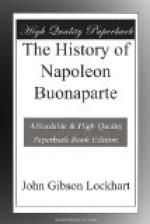It was among the Jacobins, who had formerly worshipped Buonaparte as the “child and champion” of their creed, that the first schemes of assassination were agitated. An Italian sculptor, by name Ceracchi, who had modelled the bust of Napoleon while he held his court at Montebello, arrived in Paris, and, under pretence of retouching his work, solicited admission to the presence of the new Caesar, whose Brutus he had resolved to be. The occupations of the Consul did not permit of this, and the Italian, having opened his purpose to Topineau, Lebrun, a painter, the adjutant-general Arena, Damerville, and others of kindred sentiments, arranged a plan by which Buonaparte was to have been surrounded and stabbed in the lobby of the opera house. But one of the accomplices betrayed the conspiracy; and Ceracchi and his associates were arrested in the theatre, at the moment when they were expecting their victim.
This occurred towards the middle of August; and it has been said that the Jacobin conspirators, being thrown into the same prison with some desperadoes of the Chouan faction, gave to these last the outline of another scheme of assassination, which had more nearly proved successful. This was the plot of the infernal machine. A cart was prepared to contain a barrel of gunpowder, strongly fastened in the midst of a quantity of grape-shot, which, being set on fire by a slow match, was to explode at the moment when Buonaparte was passing through some narrow street, and scatter destruction in every direction around it. The night selected was that of the 10th of October, when the Chief Consul was expected to visit the opera, and the machine was planted in the Rue St. Nicaise, through which he must pass in his way thither from the Tuileries. Napoleon told his friends at St. Helena, that having laboured hard all day, he felt himself overpowered with sleep after dinner, and that Josephine, who was anxious to be at the opera, had much difficulty in at last rousing and persuading him to go. “I fell fast asleep again” (he said), “after I was in my carriage; and at the moment when the explosion took place, I was dreaming of the danger I had undergone some years before in crossing the Tagliamento at midnight, by the light of torches, during a flood.” He awoke, and exclaimed to Lannes and Bessieres, who were with him in the coach, “We are blown up.” The attendants would have stopped the carriage, but,




